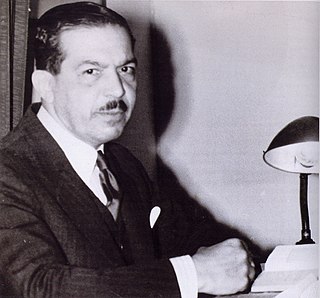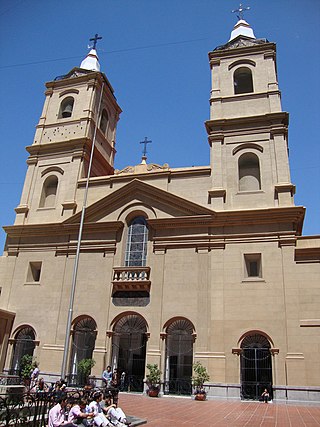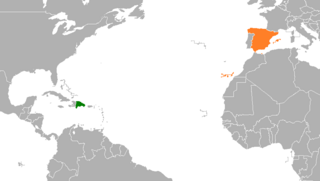
Latin America, sometimes referred to as LatAm is a large cultural region in the Americas where Romance languages — languages derived from Latin — are predominantly spoken. The term was coined in the nineteenth century, to refer to regions in the Americas that were ruled by the Spanish, Portuguese and French empires. The term does not have a precise definition, but it is "commonly used to describe South America, Central America, Mexico, and the islands of the Caribbean." In a narrow sense, it refers to Spanish America plus Brazil. The term "Latin America" is broader than categories such as Hispanic America, which specifically refers to Spanish-speaking countries; and Ibero-America, which specifically refers to both Spanish and Portuguese-speaking countries while leaving French and British excolonies aside.

Santo Domingo, once known as Santo Domingo de Guzmán and Ciudad Trujillo, is the capital and largest city of the Dominican Republic and the largest metropolitan area in the Caribbean by population. As of 2022, the city and immediate surrounding area had a population of 1,484,789, while the total population is 2,995,211 when including Greater Santo Domingo. The city is coterminous with the boundaries of the Distrito Nacional, itself bordered on three sides by Santo Domingo Province.

A caudillo is a type of personalist leader wielding military and political power. There is no precise definition of caudillo, which is often used interchangeably with "warlord" and "strongman". The term is historically associated with Spain, and with Hispanic America after virtually all of the region won independence in the early nineteenth century.

Carlos María de Alvear, was an Argentine soldier and statesman, Supreme Director of the United Provinces of the Río de la Plata in 1815.

The Viceroyalty of the Río de la Plata meaning "River of the Silver", also called "Viceroyalty of the River Plate" in some scholarly writings, in southern South America, was the last to be organized and also the shortest-lived of the Viceroyalties of the Spanish Empire in the Americas. The name "Provincias del Río de la Plata" was formally adopted in 1810 during the Cortes of Cádiz to designate the Viceroyalty of the Río de la Plata

The British invasions of the River Plate were two unsuccessful British attempts to seize control of areas in the Spanish colony of the Viceroyalty of the Río de la Plata that were located around the Río de la Plata in South America – in present-day Argentina and Uruguay. The invasions took place between 1806 and 1807, as part of the Napoleonic Wars, when Spain was an ally of Napoleonic France.
Miraflores is the name of several places in Spanish-speaking countries. It means "behold the flowers" or "flowers view" from mirar and flores ("flowers").
Santo Domingo is the capital of the Dominican Republic.
In the struggle for the independence of Spanish America, the Reconquista refers to the period of Colombian and Chilean history, following the defeat of Napoleon in 1814, during which royalist armies were able to gain the upper hand in the Spanish American wars of independence. The term used in the past century by some Colombian and Chilean historians makes an analogy to the medieval Reconquista, in which Christian forces retook the Iberian Peninsula from the Caliphate.

The decolonization of the Americas occurred over several centuries as most of the countries in the Americas gained their independence from European rule. The American Revolution was the first in the Americas, and the British defeat in the American Revolutionary War (1775–1783) was a victory against a great power, aided by France and Spain, Britain's enemies. The French Revolution in Europe followed, and collectively these events had profound effects on the British, Spanish, Portuguese, and French colonies in the Americas. A revolutionary wave followed, resulting in the creation of several independent countries in Latin America. The Haitian Revolution lasted from 1791 to 1804 and resulted in the independence of the French slave colony. The Peninsular War with France, which resulted from the Napoleonic occupation of Spain, caused Spanish Creoles in Spanish America to question their allegiance to Spain, stoking independence movements that culminated in various Spanish American wars of independence (1808–33), which were primarily fought between opposing groups of colonists and only secondarily against Spanish forces. At the same time, the Portuguese monarchy fled to Brazil during the French invasion of Portugal. After the royal court returned to Lisbon, the prince regent, Pedro, remained in Brazil and in 1822 successfully declared himself emperor of a newly independent Brazilian Empire.

Pedro Henríquez Ureña was a Dominican essayist, philosopher, humanist, philologist and literary critic.

The Haitian occupation of Santo Domingo was the annexation and merger of then-independent Republic of Spanish Haiti into the Republic of Haiti, that lasted twenty-two years, from February 9, 1822 to February 27, 1844. While many Haitians view the invasion and occupation of Spanish Santo Domingo as a "unification" of the island designed to protect their country from re-enslavement via the Spanish side, Dominicans consider it as a forced military invasion and occupation. The Haitian occupation's suppression of Dominican culture, forceful redistribution of Dominican wealth, and strict policies based on labor led to growing resentment that culminated in a Dominican movement for national independence, which was attained in February 1844.

The Spanish American wars of independence were numerous wars in Spanish America with the aim of political independence from Spanish rule during the early 19th century. These began shortly after the start of the French invasion of Spain during the Napoleonic Wars. Thus, the strict period of military campaigns would go from the battle of Chacaltaya (1809), in present-day Bolivia, to the battle of Tampico (1829), in Mexico.

Manuel del Cabral was a Dominican poet, writer, and diplomat. The son of Mario Fermín Cabral y Báez, an influential senator during the "Era of Trujillo", he served at the Embassy of the Dominican Republic to Argentina. During his long stay in Buenos Aires, he married an Argentine and fathered his 4 children, among them, the television journalist and politician Peggy Cabral. In 1992 he was awarded the Premio Nacional de Literatura.

The military history of South America can be divided into two major periods - pre- and post-Columbian - divided by the entrance of European forces to the region. The sudden introduction of steel, gunpowder weapons and horses into the Americas would revolutionize warfare. Within the post-Columbian period, the events of the early 19th century, when almost all of South America was marked by wars of independence, also forms a natural historical juncture. Throughout its history, South America has had distinct military features: it has been geographically separated from many major military powers by large oceans; its unique terrain has imposed major logistical challenges, and privileged naval lines of communications.
The military history of North America can be viewed in a number of phases.
This is a timeline of events related to the Spanish American wars of independence. Numerous wars against Spanish rule in Spanish America took place during the early 19th century, from 1808 until 1829, directly related to the Napoleonic French invasion of Spain. The conflict started with short-lived governing juntas established in Chuquisaca and Quito opposing the composition of the Supreme Central Junta of Seville. When the Central Junta fell to the French, numerous new Juntas appeared all across the Americas, eventually resulting in a chain of newly independent countries stretching from Argentina and Chile in the south, to Mexico in the north. After the death of the king Ferdinand VII, in 1833, only Cuba and Puerto Rico remained under Spanish rule, until the Spanish–American War in 1898.

The Santo Domingo Convent, or Basilic of Our Lady of the Rosary and Convent of Santo Domingo is a convent for Our Lady of the Rosary located in the Monserrat neighborhood of Buenos Aires. Built during the colonial times, it was the scenario of a military conflict during the British invasions of the Río de la Plata. It holds as well the tomb of the Argentine national hero Manuel Belgrano.

The Union of Ibero-American Capital Cities, UCCI, is an international, non-governmental organization of 29 major Ibero-American cities that fosters ties and friendly relations between its members. Founded in October 1982, the union is headquartered in Madrid.

Dominican Republic–Spain relations refers to the diplomatic relations between the Dominican Republic and Spain. Both nations are members of the Association of Academies of the Spanish Language and the Organization of Ibero-American States.














